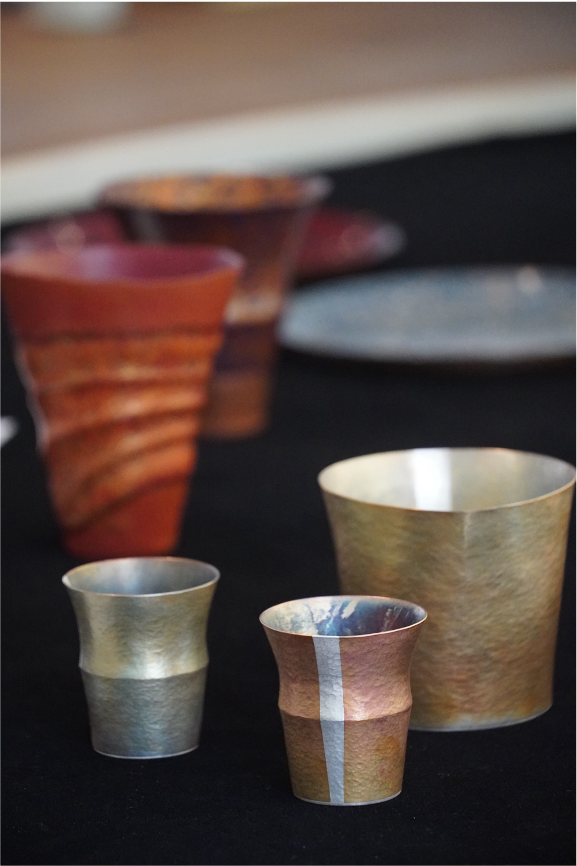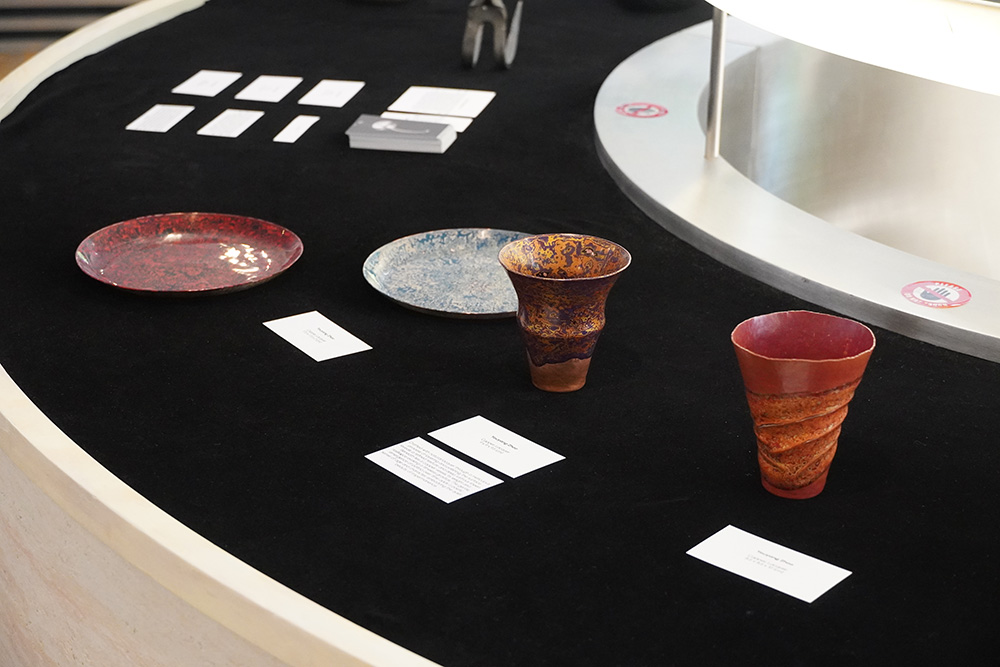In the shifting landscape of contemporary craft, one question echoes with increasing urgency: how do traditional methods remain alive without becoming frozen in time? Can the language of handcraft still speak—relevantly, poetically—within a hyper-digital, fast-paced material world?
These questions lie at the heart of the practice of London-based metalsmith and jewellery artist Youyang Zhao. His two most recent bodies of work, exhibited as part of Unanchored Crafting during London Craft Week 2025 at Alsolike Gallery, offer nuanced responses. The Lacquered Metal Vessel Series and the Sake Set Series are not simply aesthetically refined objects; they represent a sustained inquiry into the limits and possibilities of craft, the tension between permanence and transformation, and the interplay between tradition and reinterpretation.
A Craft Rooted in Hammering
Zhao’s background in metalsmithing and jewellery design began in Taiwan, where he studied at Fu Jen Catholic University, before continuing his education at the Royal College of Art in London. His practice centres on hammering—not only as a technique for shaping metal, but as a mode of sensory engagement. Over time, he has cultivated an intimate understanding of how metal responds to impact, developing a sensitivity to its resistance, flexibility, and subtle transformations.
His vessels are conceived as miniature sculptures. Rather than pursuing symmetry or industrial regularity, he embraces asymmetry, ambiguity, and organic imperfection. Each curve and contour reflects a pursuit of harmony within imbalance. This approach allows his work to preserve the tactility of handcraft—retaining surface textures, minor inconsistencies, and deliberate flaws that invite closer attention and reveal a layered, living aesthetic.
Zhao’s particular sensitivity to materials is further informed by his deep commitment to traditional silversmithing techniques. Each vessel undergoes an intensive process of shaping, refining, and detailing—from raising and forming to the final patination. This physical engagement with the material becomes a meditative act, through which knowledge is not only applied but continuously rediscovered.
Reimagining Lacquer Through Metal
The Lacquered Metal Vessel Series challenges conventional associations between lacquer and its traditional substrates such as wood or bamboo. In this body of work, Zhao applies the Japanese hen-nuri (変塗) technique—typically used to achieve translucent layering—to hammered copper vessels. The lacquered areas appear rich and luminous, while the exposed copper surfaces are chemically patinated, producing dynamic colour variations that shift with time and temperature.
This juxtaposition between the enduring quality of lacquer and the evolving nature of copper creates a temporal duality. The process highlights a dialogue between stability and change, with each vessel embodying two timelines within a single form. Rather than concealing the raw texture of the metal, the lacquer accentuates it, allowing each layer to become part of a broader narrative of endurance, refinement, and material contradiction.
The series exemplifies Zhao’s exploration of how culturally and functionally bound materials can be re-contextualised without losing their historical depth. Through this merging of techniques, the works evoke new meanings that reach beyond the decorative, proposing lacquer as a resilient medium of contemporary expression.
Moreover, the works draw attention to the act of preservation in craft: while the lacquer seals and stabilises the surface, the copper’s patina remains active and responsive to environmental conditions. This co-presence of control and unpredictability allows each vessel to become a site of material negotiation, one in which durability and change are in constant dialogue.
Reconnecting Hand and Function
The Sake Set Series approaches a different line of inquiry—one rooted in the relationship between object and user. Drawing from the sensorial rituals of Japanese sake culture, these vessels are designed to engage both the eye and the hand. They are formed from silver and copper sheets, soldered and meticulously hammered to fit the natural curvature of the hand.

Flame patination lends the copper surfaces a vibrant spectrum of colour, ranging from warm oranges to deep purples, while the silver introduces a visual and tactile contrast. Every curve is refined through countless hammer strikes, resulting in minimalist forms that prioritise both comfort and clarity. The simplicity of the silhouettes belies the complexity of their making; each vessel is crafted to deliver not only functionality but a subtle, embodied experience.
The vessels are designed not only for use but for ritual. Their scale and proportion reflect an awareness of how physical gestures shape emotional presence. A cup that fits gently in the palm becomes an invitation to pause, to savour, to connect.
Continuing from Zhao’s earlier investigations into mixed-metal vessels at the Royal College of Art, the Sake Set Series demonstrates a seamless balance between utility and refinement. Its nomination for the 2024 ITAMI International Craft Exhibition affirms the resonance of this work within an international dialogue on contemporary craft.
Between Object and Experience
Across both series, Zhao presents the vessel as more than a utilitarian form—it becomes a container of time, process, and sensory memory. His objects operate in the space between sculpture and function, offering tactile encounters that invite contemplation. The surface tensions between polished and rough, rigid and curved, internal and external—these contradictions are not resolved, but held together, forming complex, layered presences.
Rather than updating traditional techniques for the sake of novelty, Zhao constructs forms that carry multiple material histories. His works do not collapse cultural or temporal differences but allow them to coexist—unstable, open-ended, and quietly potent.
This approach positions Zhao’s work within a broader rethinking of craft: as a space for inquiry rather than resolution, as a process rather than a product. In an era increasingly dominated by immediacy and spectacle, these vessels offer an alternative pace—slow, precise, and grounded in tactile wisdom.
Zhao’s contribution to Unanchored Crafting aligns closely with the exhibition’s curatorial vision, which foregrounds cultural dislocation and material experimentation in craft. His works engage in this dialogue not through spectacle, but through subtlety—through care, labour, and unresolved questions.
Positioned between disciplines and categories, Zhao’s vessels resist easy definition. They are objects that question their own making, their own function, and their own boundaries. In doing so, they offer an alternative pace—inviting viewers to slow down, to feel, to reflect.
These are not declarative objects. They are quiet invitations: to hold time in the hand, to sense transformation through surface, and to imagine tradition not as a fixed reference, but as a material still capable of change.

